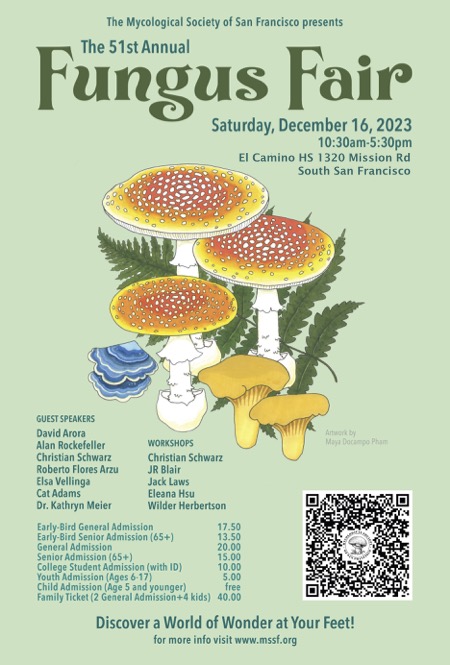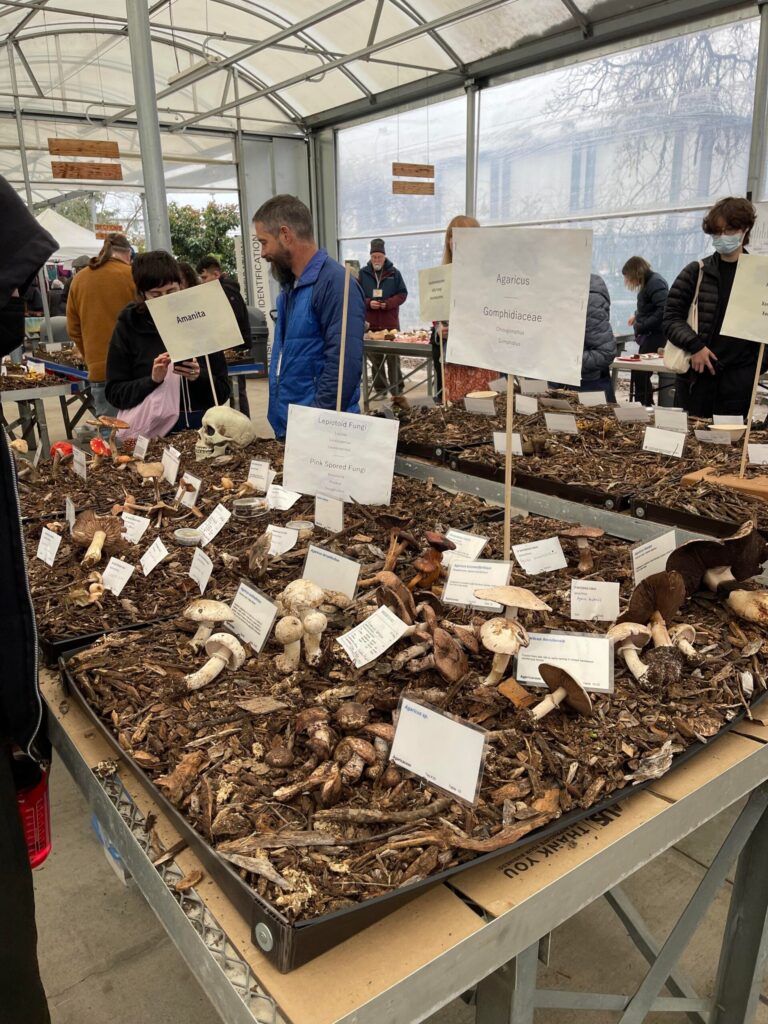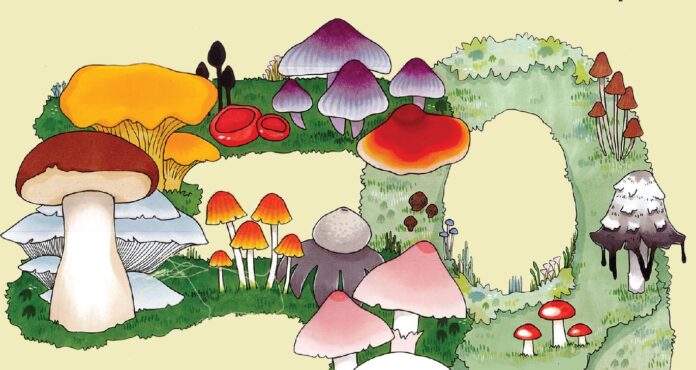Tremendous energy and surging interest in fungi such as mushrooms and toadstools has become a “shroom boom” phenomenon.
There are chefs exploring new ingredients and flavors, researchers studying the impact of psychedelic substances on mental health disorders, weekend foragers enthused by the hunt, medical professionals and naturopaths choosing to offer patients alternative approaches to health care, artists seeking natural dyes, ecologists focusing on habitat decimation’s effect on food chains, members of general public investigating plant-based foods and beverages, acclaimed documentaries and series abounding. It’s fair to say, mushrooms are having a moment in almost every corner of contemporary society and culture.
Which is why the Mycological Society of San Francisco’s 51st Annual Fungus Fair (Sat/16 at El Camino High School, South San Francisco) arrives at a highly prescient time. The 7-hour exhibition includes hands-on mushroom activities for all ages, workshops and panels featuring recognized experts, displays of over 300 locally collected fungi, an identification table where specimens brought by participants can be classified, and educational displays addressing fungi in medicine, cultivation, ecology, textile dyes, toxicology. Products and materials used for foraging, studying, or consuming mushrooms are available for purchase and in-person, elbow-to-elbow interactions allow for considerable, casual exchange. Everyone, from novice shroom boomers to the Bay Area’s most experienced mycologists can find something of value at the society’s popular fair.
Of course, mushrooms have, since ancient times, been sought out not only for eating and textile dyes, but for their medicinal and—within a certain sector—psychoactive properties. Used by Indigenous people in medical traditions and spiritual rituals for centuries, the psilocybin mushrooms, the species commonly referred to as “psychedelic mushrooms,” have demonstrably produced mystical experiences. Institutions like Johns Hopkins Hospital and the National Institute of Health are studying their use in helping people with depression, obsessive-compulsive disorder, and other psychological conditions.

On the darker side of the shroom: Because mushrooms are edibles and some varieties are highly toxic, the implications for and actual evidence of lethal mushroom poisonings is widely, if imperfect, known. Forager misidentification can be attributed to most incidents (and is suspected to have led most famously to the death of the Roman Emperor Claudius). But not everyone is aware that of the 6,000 average toxic ingestions annually in the United States, over half involved children six-years-old and under. Nor do casual foragers or those curious youngsters understand that beyond gastrointestinal distress lie dangers caused by eating toxic mushrooms including severe damage to the liver, seizures, and roiling hallucinations.
Inevitably, rampant misinformation lights up the savage digital landscape of the internet. Disputes, myths, fake news, false studies and arguments about mushrooms abound. As with other topics, sensational exaggerations get the most clicks and often go viral, exponentially increasing the impact.
In an interview, mycologist, naturalist, and writer David Arora says his “Mushrooms Demythified” talk at the fair will focus on dispelling common mushroom myths, especially those fueled by the internet.
“One thing I’m going to talk about are not mushroom myths of the past, but contemporary ones strengthened by social media. I will encourage people to not just read the hype. Those statements about cures for ailments are largely overblown. Yes, there are some promising mushrooms, but the large peer review studies with controls; the kinds of studies we have with other medicines? They just aren’t there yet. People think if they go out and get some Turkey Tails and make tea, it will help them. Just having one cup of tea will not lead to health enhancement, although there’s no harm.”
What is harmful, according to Arora and other experts, is when people have no sense of the importance of dosage. There is internet information about mushrooms making a person sick, but less obvious details concerning the types for which moderate consumption is key are lacking. Also, the same non-toxic mushrooms have been proven to impact people differently depending on a host of factors. Often, people without training or specifically educated about preparing mushrooms don’t know the traditions or techniques for preparing them to be consumed safely.
With all of the dangers, new or advancing technologies have resulted in some improvements that benefit mushroom exploration and education. “There’s definitely technology that made color printing cheaper and that means guides published in the last decade are possible and more available,” Arora says. “And there are sites that can have positive aspects through identifying groups that most of the time get it right. The caution comes in that if it was identifying a bird and they get it wrong, it won’t matter because you won’t be eating it. But with mushrooms, it’s different. There aren’t really good apps yet; the best now have 70 percent accuracy. You want 100 percent if you’re going to be eating a mushroom.”
Until greater accuracy related to online apps and accuracy happens, training and mentoring from an experienced forager or educator is optimal, says Dr. Kathryn Meier. As a Senior Toxicology Management Specialist with the California Poison Control System, a division managed by the University of California at San Francisco, Meier’s presentation at the fair is titled, “Mushroom Malady: Recognizing Mushroom Poisoning Syndromes, Mechanisms, and Treatments.”

“There is importance because people need to understand the risk of mistakes in identification. In my talk, it won’t be so complicated people can’t follow along. I’ll talk about major groups of mushrooms and general risks and why it’s critically important to avoid some of the most dangerous. The part on mechanism helps people understand the risks, especially of the liver toxic mushrooms. With those, people don’t develop symptoms until it’s already started to destroy the liver. By the time they show up at the hospital or a clinic, the toxic process is ongoing and you hope to be able to salvage their liver. There’s a huge risk because by that time, the cart’s already out of the barn.”
The mixed metaphors in the idiom are familiar, but not issued lightheartedly by Meier, given the seriousness of the medical reality. Which is why she goes on to say, “It’s vital that people get mentoring and experience before going out and foraging and consuming mushrooms on their own. We get a lot of exposures, especially young people exploring. Those are usually mild exposures. The most serious exposures are people who are inadequately trained and mistake a mushroom for something that’s edible. They might think they’re getting a chanterelle, but they’re getting the Jack-o’-lantern, which I call among the vomiting mushrooms. They should join a mycological society and get training.”
Meier’s additional suggestions, especially pertaining to protecting those ever-exploring toddlers who see a bright blue mushroom in the lawn and within seconds, pop it in their mouths and wind up in the doctor’s office or an emergency room, include a information published on the California Poison Control System website.
“We’ve worked with mycology and toxicology folks who’ve come up with a treatment key that shows the symptoms and the best treatments. We can’t control the toddler on the front lawn, so we want people to just call the poison center so they don’t have to guess. The people there are highly trained and it’s a great resource for parents with children or adults who’ve been exposed. Another resource is the SF Mycological Society that’s putting on this fair. They offer articles and books people can use to do research. But without direct training to discern an edible mushroom, we say it’s ill-advised to consume what could be toxic.”
Asked about the psychedelic mushrooms, Meier says people fall into two camps. Some people support completely separating the consciousness-alternating experience from scientific settings; others advocate for more studies conducted in a controlled setting to determine if mushrooms can be used and are helpful for psychiatric conditions. “There is interesting information being presented, but there’s nothing conclusive at this time. Micro-dosing of psycho-active psilocybin compounds might have promise for some types of psychiatric problems but it’s not a first-line treatment yet. Until there’s more data, we also don’t know who will benefit from this. The treatment for person A might be completely different than for person B. Right now, the investigations are just beginning,” says Meier.
Her hope for the impact of the fair’s workshops and displays she said will be evidenced by increased appreciation, wonder and curiosity about the use of mushrooms in the culinary and textile arts and fungi’s importance in ecology. Arora, who knows that foraging in European countries such as Ukraine, Poland, Czechoslovakia and China, has always been more robust than in the US, says he’d like to see a reduction in the problem that most limits Americans’ foraging opportunities. Regulations that limit public land use in our coastal region, Arora suggests, have an inverse relationship of hunting versus regulation that produces a default position of “don’t touch anything, don’t forage anything.”
“A study in Poland showed people hunting for mushrooms was at 50 percent. We are nowhere near that. I would hope in the next few years revised regulations would make it easier for people to gather mushrooms legally. Foraging encourages a relationship with nature. You learn about trees, ground cover and what makes certain mushrooms grow where. I hope that people will be able to broaden their menu and learn beyond the five or six types that get a lot of hype. It’s less enjoyable to hunt for only two kinds.”
MYCOLOGICAL SOCIETY OF SAN FRANCISCO’S 51ST ANNUAL FUNGUS FAIR Sat/16, 10:30am-5:30pm, at El Camino High School, South San Francisco. More info here.




